Availability of Surface Water of Wadi Rajil as a Source of Groundwater Artificial Recharge: A Case Study of Eastern Badia /Jordan
Rakad A.Ta any1 *
1
Department of Water Resources and Environmental Management,
Faculty of Agricultural Technology,
Al-Balqa-Applied University,
Al-Salt,
Jordan
DOI: http://dx.doi.org/10.12944/CWE.8.2.04
Copy the following to cite this article:
Taany R. A. Availability of Surface Water of Wadi Rajilas a Source of Groundwater Artificial Recharge: A Case Study of Eastern Badia /Jordan. Curr World Environ 2013;8(2) DOI:http://dx.doi.org/10.12944/CWE.8.2.04
Copy the following to cite this URL:
Taany R. A. Availability of Surface Water of Wadi Rajilas a Source of Groundwater Artificial Recharge: A Case Study of Eastern Badia /Jordan. Curr World Environ 2013;8(2). Available from: http://www.cwejournal.org/?p=4794
Download article (pdf)
Citation Manager
Publish History
Select type of program for download
| Endnote EndNote format (Mac & Win) | |
| Reference Manager Ris format (Win only) | |
| Procite Ris format (Win only) | |
| Medlars Format | |
| RefWorks Format RefWorks format (Mac & Win) | |
| BibTex Format BibTex format (Mac & Win) |
Article Publishing History
| Received: | 2013-07-09 |
|---|---|
| Accepted: | 2013-08-15 |
Azraq basin is located in the Northeastern part of Jordan and extends northwards into Syria and southwards into Saudi Arabia. The Azraq Oasis (called locally Sabkhah or Qa’a Azraq) which is located in the central part of the basin is at a distance of about 120 km northeast of Amman. Qa’a Azraq is a relative large mudflat located in the central part of the basin. Two villages are located on the western side of the Qa’a Azraq; these are Azraq Shishan and Azraq Druze. A well field called AWSA was established north of Azraq Druze Springs (northern springs) where about 15â€20 million m3 per year (MCM/a) of water is pumped to the capital Amman for drinking purposes since 1982. Farmers in the area are using around 45 MCM/a. Therefore, the total abstraction from the basin is about 65 MCM/a (Elâ€Naqa et al., 2007).
The over-pumping from the shallow groundwater aquifers, the water level dropped dramatically and signs of salinization and depletion are starting to occur. Therefore, it is necessary to determine the location of this interface, since saline water, intrusion has started and is predicted to accelerate in the near future. (Bajjali, and Hadidi, 2005).
A number of major wadis drain radially into the Azraq depression. These wadis are characterized by wadis shallow flow-beds with relatively low slopes. None of the wadis within the basin is being gauged.Wadi Rajilcatchment area is considered as one of the most significant wadi draining the Azraq basin from its northern part. The general shape of Wadi Rajilcatchment area is trapezoidal, with its longer axis in general oriented NE-SW direction. The slope of the area is from NW to SE and the average slope of stream channels varies from 1% to 3% Elevation ranges from 1550 m above mean sea level (a.m.s.1) at Salkhad in Syria to 500 m a.m.s.1 at Qaa' Azraq. Considerable part of the drainage is nearly flat.
The main objective of this study is to estimate the peak discharge and the flood volumes for different return period in Wadi Rajil catchment area, and the potentiality of using this water for groundwater artificial recharge.
Materials and Methods
Description of the Study Area
Wadi Rajil catchment area lies between 313 to 400 E and 138 to 228 N According to Palestine Grid, and it covers 3910 km2, Figure 1.Intermittent flow in the wadi occurs in winter and drains into Qaa' Azraq, where it evaporates within a few months without utilization.
The climate in the Azraq Basin belongs to the Mediterranean bio-climatic region, which is characterized by dry hot summers and wet, cold winter. Most of the study area is arid and small portion can be considered as semi-arid. As in most arid and semi-arid areas, temperatures exhibit large seasonal and diurnal variations with absolute daily temperatures ranging from a maximum of about 46 ºC (January of 1993), (JMD, 2010).
The thunderstorm rainfalls from the great part of the total rainfall in the study area, which is characterized by irregular intensity and duration. The heaviest rainfall over 24 hours is usually recorded between December and March and no significant normal rainfall is to be expected in October and May. The average annual rainfall over the sub-catchment area is 126.6 mm and ranges between less than 50mm in the south to more than 300 mm in the northern part of the sub-catchment.
Geology
Azraq Basin in general and Wadi Rajil catchment area in particular is a part of the limestone plateau in east Jordan. The northern part of this plateau is covered by six basalt flows, tuff and volcanic eruption originated mainly in Jabel Arab in Syria and many other relatively small volcanoes in the area occurred during the Miocene-Quaternary. These flows overlie Tertiary rocks in the northern part of the catchment area.
The youngest sediments in the Qaa' consists of gravels and sands of fluviatile origin (NRA, 1992).The outcropping formations are, the Rijam and wadi Shallala in the central and eastern part of the basin, both of Eocene age.
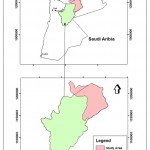 |
Figure 1: Location Map of Wadi Rajil Area Catchment Area Click here to View figure |
The northern part of the Azraq basin is dominated by Miocene to Pleistocene basalt whereas to the west and south by Rijam and Muwaqqar formations of late cretaceous- Early Tertiary age. Regional distribution of the outcropping geological formations is shown in Figure 2.
The area as the whole of Jordan was effected by the transgressions and regressions that occurred during the time from Cenomanian until upper Eocene (NRA, 1992).
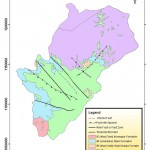 |
Figure 2: Geological map of the Azraq Basin Click here to View figure |
These transgressions and regressions are represented in the Azraq Basin by the changes of facies in the Ajlun Group (limestone, dolomite, marl, shale and dolomitic limestone) and Belqa Group (marl,limestone ,chert, silicified, limestone, dolomite and chalk),that crop out in the central, western and southern part of the basin. During the period from upper Oligocene and into the lower Miocene, the Azraq Basin has gone under erosion and tectonic activity,(Bender, 1974).
In the Azraq playa (wetland reserve), the basalt is missing. Upper Tertiary sediments (B5) (Wadi Shallala) are located in the structural depression zones. The (B5) Formation consists of Marly†Clayey layers in the area of AWSA well field and acts here as an aquitard between the B4 (Rijam) and the Basalt aquifer. Towards the southeast, the B5 Formation contains more sandy layers and it is classified as an aquifer in this area. South of the basalt areas Paleocene and Eocene,marly limestone, chalks, and chalky limestone with chert layers of the B4 formation, dominate the landscape. The B4 formation is underlain by the Maastrichtian B3 (Muwaqqar) formation. B3 formation reaches a thickness of about 300 m and consists of marl and marly limestone with some gypsum and evaporite. The underlying Campanian to Turonian B2/A7 formations (Amman/Wadi Sir) is mainly formed by chert and limestone, (Elâ€Naqa, 2010).
Methodology
There are several methods for determining the peak discharge in un-gauged watersheds. In this study, the SCS-curvilinear synthetic unit hydrograph concept was applied to estimate the peak discharge for the un-gauged Wadi Rajil catchment area.
Derivation of the Unit Hydrograph
The most common method of deriving unit hydrograph synthetically is the soil conversation services (SCS) curvilinear unit hydrograph method, Chow, et al, 1988, Wanielista, 1990). The time to peak or the time required to reach the peak discharge (Tp) is defined as:
Tp=Dr/2+La … (1)
Where, Tp=is time to peak in hours Dr= is the standard duration of rainfall La= is the lag time The lag time (La) is calculated from the following formula;
La = Ct ((L* Lc)/√ (Sl)) ^0.38 …(2)
Where, Ct is aregional constant representing watershed slope and storage (Subramanya, 1984, Chow et al, 1988, Linsely, et al, 1988), L, is the hydraulic length, Lc,is the centroid length and S1 , is the slope. The standard duration of rainfall (Dr) is calculated as:
Dr=La/5.5 …(3)
The peak discharge (Qp) can be calculated using the SCS formula:
QP=(484/TP)*A ...(4)
Where, A, is the catchment area in (mi2) and Qp in ft3/sec (cfs).
Critical Arrangement of the Storm
The incremental values of the storm of certain return period (e.g. 25-year), were arranged in descending order and re-arranged as shown in Table 1, below:
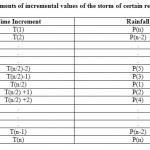 |
Table 1: Arrangements of incremental values of the storm of certain return period Click here to View table |
From this arrangement, it is indicated that T (n) is the last time increment in 24 hrs andP (1) is the first and consequently the maximum incremental rainfall. This is the critical arrangement of the storm, which produces maximum peak discharge in its flood, (Matthai, 1969).
Derivation of the Flood Hydrographs
The flood hydrograph of each frequency storm is derived by combining of the hydrograph obtained for each incremental net rainfall or runoff (r1, r2,……., ri). In this combination procedure, the shifting of the hydrographs according to its time increment should be considered, (Chow et al., 1988).
Estimation of peak discharge
In this study, the unit hydrograph approach is applied to determine the peak discharge values.The hydrologic characteristic of the drainage area such as the area of the basin(A),hydraulic length (L), centroid length (Lc) and the elevation deference between the highest point of the main stream and the outlet(H) are calculated from the topographic maps related to the catchment.Whereas the Curve Number (CN) is calculated from the topographic maps, geologic maps and land use map available for Azraq Basin. The calculation of the unit hydrograph (UH) and the derivation of the flood hydrographs of 10, 25,50and 100years return period for Wadi Rajil catchment area were performed.
Unit Hydrograph of Wadi Rajil Catchment Area
The calculation of UH of Wadi Rajil Catchment areawas done using the English unit, then the obtained peak discharge(Qp)values were converted to the metric units. The parameters taken from the topographic map were:
A=1527.3 square mile (mi2)
L=118.75 mi
Lc= 59.38 mi
H=3444.9 ft
From Equation (2), the calculated lag time (La) is: La= 1.2((118.75*59.38)/√29)^0.38
La = 18.35 hrs.
From Equation (3), the standard duration (Dr) is: Dr= 18.35/5.5 Dr = 3.34 hrs. The La value is corrected for Dr = 1 hr. instead of 3.34hr, using Snyder's Formula: L'a=18.35+(D'r-Dr)/4 L^' a=18.35+(1-3.34)/4=17.765 hrs. Where, L' a is the corrected lag time andis one hour duration. Then, theTp was calculated using formula (1): TP=1/2+17.765 TP=18.265 hrs. Finally, the estimated Qp was obtained using Equation (4): QP=(484/18.265)*1527.3 = 40471.6 or 1146 m3 / sec (cms) The T/Tp and Q/Qp values of the generalized dimensionless UH of the SCS were used to derive the synthetic UH of Wadi Rajil catchment area. Table 2, shows the calculation of Wadi Rajil UH. The UH of Wadi Rajil is also illustrated in Figure 3.
Derivation of Wadi Rajil Flood Hydrographs
The intensity duration frequency curves (IDF) of Azraq rainfall station and the CN method mentioned previously, were utilized to calculate the effective rainfall (runoff). The IDF curves are shown in Figure 4.From these curves ,the 10 ,25,50 and 100 years return period rainfalls for duration of 24 hours were obtained hourly, the results of calculation are tabulated in Tables (3,4,5,and 6).These tables also show the critical arrangement of the incremental rainfall to obtain the maximum flood of 10,25,50 and 100 years return period storm.
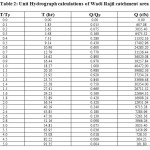 |
Table 2: Unit Hydrograph calculations of Wadi Rajil catchment area Click here to View table |
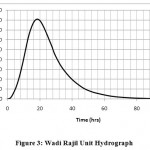 |
Figure 3: Wadi Rajil Unit Hydrograph Click here to View figure |
The incremental runoff values were applied to the UH with the time lag, and the individual hydrographs were obtained for each incremental runoff. The addition of these hydrographs give the total storms hydrographs .The application of the procedure to 10,25,50,and 100 years storms for Wadi Rajil catchment are shown in Table 7and the resulted flood hydrographs are illustrated in Figure 5. The calculated peak discharges were 10.8,186,412and 680 m3/sfor the 10, 25, 50, and 100 year return period respectively. The calculated flood volumes were 0.95,16.5,36.9and 61.5 million cubic meter (MCM)for the 10,25,50,and 100 year return period respectively.
Possibilities of Artificial Recharge
As noticed from the previous section, the study area in particular as well as desert area in Jordan in general receive a low precipitation amount, where most of rainfall occurs in few storms of high intensity and short duration. Flush floods occur in desert areas, due to the low infiltration index. Most of the floodwater evaporates and very little amount for the time being has been utilized. Due to this, the ideal solution is the better management of such water by using it in the replenishment of the over pumped aquifer by artificial recharge techniques.
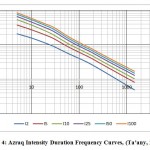 |
Figure 4: Azraq Intensity Duration Frequency Curves, (Ta’any, 2002). Click here to View figure |
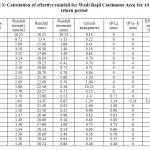 |
Table 3: Calculation of effective rainfall for Wadi Rajil Catchment Area for 10-year return period Click here to View table |
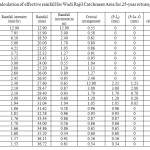 |
Table 4: Calculation of effective rainfall for Wadi Rajil Catchment Area for 25-year return period Click here to View table |
Artificial recharge is essential on enhancement of natural recharge ; therefore an understanding of the hydrologic cycle precedes developments of sites selection criteria .Five facets of the hydrologic cycle that need to be well understood(Chidly,1981). These are precipitation, surfaceinfiltration, soilmoisture, surface runoff, interflow, and evapotranspiration. In addition to these facts, the following questions must be quantified concerning viable sites selection criteria(CGWB, 1994): how much rechargeable water is available? when and at what depth ?how will the quality of water change after recharge and how quickly will the aquifer plug due to chemical, physical or bacterial processes.
Applying these points on Wadi Rajil catchment, the different parameters of the hydrologic cycle are discussed in the previous section and the results are tabulated in Tables (3, 4, 5.6 and 7). From these tables the surface runoff in the area is available during the winter season.
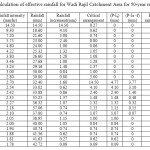 |
Table 5: Calculation of effective rainfall for Wadi Rajil Catchment Area for 50-year return period Click here to View table |
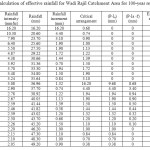 |
Table 6: Calculation of effective rainfall for Wadi Rajil Catchment Area for 100-year return period Click here to View table |
The water quality of surface runoff of Wadi Rajil is considered to be of good quality,Table 8.whereas, the electrical conductivity (EC µS/cm) is considered low and highly appropriate since the water flows mostly on the basalt floes or the weathering products of the basalts or the volcanic ashes in most of the drainage areaand in general will not affect negatively the groundwater quality in the area after its percolation through the highly fractured basalt. Talking into consideration the hydrological conditions prevailing in the Upper Aquifer Complex in the area, there is an enough space for ground water aquifer since it is all over the basin is over pumped as indicated from the groundwater withdrawals in the area of study, Figure 6. In addition, the hydraulic characteristics of the aquifer as indicated from the pump test analyses of the groundwater wells operating in the areaare as follows: the discharge, specifics capacities and transmissivities are ranging between 70-300m3/hr,0.2-35200m3/hr/m and 15-72300m2/d, respectively, (El-Naqa and Al-Shayeb 2008).Therefore, the aquifer has a good potential to accept recharged water. Furthermore, the depth of the water table in the area is ranging between 20-70m from the ground surface.
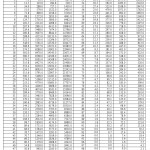 |
Table 7: Flood hydrographs of 10, 25, 50 and 100 year return period for Wadi Rajil Catchment Area Click here to View table |
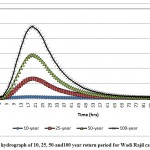 |
Figure 5: Flood hydrograph of 10, 25, 50-and100 year return period for Wadi Rajil catchment area Click here to View figure |
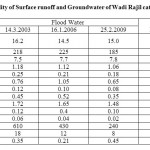 |
Table 8: Quality of Surface runoff and Groundwater of Wadi Rajil catchment area Click here to View table |
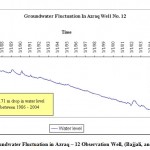 |
Figure 6: Groundwater Fluctuation in Azraq – 12 Observation Well, (Bajjali, and Hadidi, 2005) Click here to View figure |
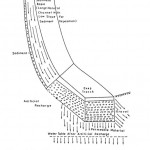 |
Figure 7: Deep Trench for Artificial Recharge Purposes Click here to View figure |
As indicated from the above discussion on the situation of Wadi Rajil catchment, artificial recharge is considered of high potential to replenish the Upper aquifer. Concerning the technique of artificial recharge, which should be developed in the study area. It is suggested to use deep trench technique, Figure 7, whereas the course of Wadi Rajil itself as well as its tributaries are of wide type and under these circumstances check or desert dams are not feasible (Rimawi et al., 1995).
The proposed technique is usually preferred by constructing successive trenches cross the wadi course.Trenches are filled with boulder, gravels and sands (volcanic ashes) in sequence from bottom to top. Using these techniques, the suspended mater will be removed and good water quality will reach the aquifer and no negative impacts will be expected in the groundwaterquality.
Conclusions
Generally, the northern part of the Azraq Basin receives higher rainfall amounts than the other parts of the basin and accordingly most of the groundwater resources are originated from north of the Azraq basin.The investigation of the availability of surface water and the prevailing conditions for groundwater artificial recharge for Wadi Rajil catchment area has led to the following results:
- The thunderstorm rainfalls from the great part of the total rainfall in the study area, which is characterized by irregular intensity and duration. The heaviest rainfall over 24 hours is usually recorded between December and March.
- The calculated peak discharges for the studied catchment area were 10.8,186,412and 680m3/s for the 10, 25, 50, and 100 return period, respectively.
- The estimated flood volumes from the resulted flood hydrographs of Wadi Rajil catchment area were 0.95, 16.5, 36.9 and 61.5 MCM for the 10, 25, 50, and 100-year return periods, respectively.
- Geological, hydrogeological and waterquality offloodwater are found to be highly suitable for artificial recharge of the Upper Aquifer System.
- Deep long narrow trenches refilled with the available basalt boulders, gravels as well as volcanic ashes will be the appropriate method to be used for artificial recharge in Wadi Rajil catchment area .
References
- Bajjali, W. and Hadidi, K., (2005). Hydrochemical Evaluation of Groundwater in Azraq Basin, Jordan Using Environmental Isotopes and GIS Techniques, Proc. of the 25th Annual ESRI International User Conference, San Diego, California, July 25 – 29,
- Bender, F., (1974). The geology of Jordan, contribution to the regional geology of the earth, supplementary edition of volume 7.Gebrueder Borntraeger, Berlin.
- Central Ground Water Board (CGWB). (1994).Manual on Artificial Recharge of Groundwater, Technical Series: M, No.3. Ministry of Water Resources, Government of India, pp 215.
- Childley,T.R.E., (1981). Assessment of groundwater recharge, Lloyd, J.W. (Ed). Case studies in ground water resources evaluation. Clarenden Press, oxford.
- Chow,V.T., Maidment,R.Dand Mays,W.L.,(1988). Applied Hydrology .International Edition, Mc Graw-Hill Book Company, NewYork.
- Elâ€Naqa, A., (2010).Study of salt-water intrusion in the Upper Aquifer in Azraq Basin. IUCN, Jordan.
- El-Naqa, A. and Al-Shayeb. A., (2008).Groundwater Protection and Management Strategy in Jordan. Springer, Water Resources Management, 23:2379–2394.
- Elâ€Naqa, A. Alâ€Momani, M.; Kilani,S. , A. and Hammour, N., (2007).Groundwater Deterioration of Shallow Groundwater Aquifers Due to Overexploitation in Northeast Jordan. Clean, Vol. 35 (2), 156 – 166.
- JMD (Jordan Meteorological Department), (2010). Annual Report, Ministry of Transport. Amman, Jordan.
- Linsely, R,K,Kohler , M, A, and Paulhus ,J.L.H., (1988). Hydrology for engineers .international (SI metric edition) McGraw Hill, N.Y, USA.
- Matthai, H.F, (1969). Floods of June 1955 in south plate River Basin, Colorado. Water Supply Paper 1850-B, U.S Geological Survey, Washington, D.C.
- NRA (Natural Resources Authority), (1992). The Geology of the Azraq Basin. Internal report of NRA, Amman, Jordan.
- Rimawi, O, Salameh, E and Abu Obeid, H., (1995). Environmental impact assessment of Wadi Rajil Dam. Internal report submitted to Azraq Oasis Project, UNDP-Sponsored Project.
- Subramanya, K., (1984). Engineering, Hydrology. Tata MC Graw-Hill Publishing Company LTD, New Delhi Metthai, H.E., 1969:”Floods of June 1955 in South Plate River Basin”, Colorado Water Supply Paper 1950-B, U.S. Geological Survey, Washington, D.C.
- Ta’any R., (2002). Rainfall –intensity- duration- frequency curves for Azraq area. Unpublished Figure. Water Authority of Jordan, Amman.
- Wanielista, M. (1990). Hydrology and Water Quantity Control, John Wiley and Sons, Inc., U.S.A.






